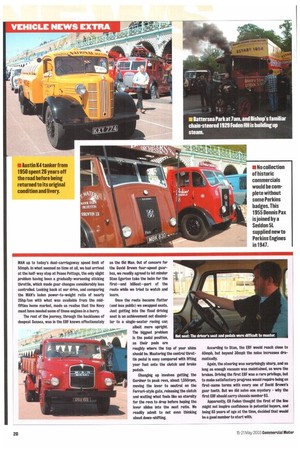Stately ERF and MAN take to the road again
Page 19

Page 20

If you've noticed an error in this article please click here to report it so we can fix it.
• As 2003 marks the 70th anniversary of the ERF brand, current owner MAN decided to celebrate the occasion by giving the very first ERF an airing on the RCVS run. Joining the ERF was the group's MAN Type 415 L1 dating from 1954. CM and sister magazine Truck were privileged to be invited to share the driving; CM opted to do the first stint in the MAN.
The story behind the MAN's arrival in the UK is something of an enigma. What is known is that it was one of a handful bought by the Ministry of Defence and used by the Royal Navy to transport submarine engines. but why it was chosen in preference to the plethora of British lorries available is unknown.
Its right-hand drive is apparently factory heft, given that not just the driving controls but the whole cab architecture is right-handed. Power Is from an MAN 00026M1 diesel producing 215hp, driving through a five-speed gearbox, although apparently it should be a ZF six-speeder.
Getting behind the large steering wheel revealed a reassuringly conventional set of controls apart from the gearshift, laid out with first to the right and back, second forward in the central plane and so on. Apart from low-speed manoeuvring around the confines of Battersea Park and the occasional hill start, second is more than adequate for moving off in the unladen MAN.
Shifting up through the unsynchronised 'box was soon mastered once the feel for the double-declutching was gained, *though unusually, fourth to fifth proved trickier than down-shifting. The lively performance and surprisingly precise steering meant we had little trouble coping with the early Sunday morning traffic through South London, although the tiny mirrors and high body sides called for extra vigilance to cope with unsympathetic car drivers. The usually tricky right turn in Streatham was helped this year by a couple of the Met's finest over-ruling the lights in the Run's favour.
Out In the country, we had no trouble winding the MAN up to today's dual-carriageway speed limit of 50mph. In what seemed no time at all, we had arrived at the half-way stop at Pease Pottage, the only slight problem having been a gradually-worsening sticking throttle, which made gear changes considerably less controlled. Looking back at our drive, and comparing the MAN's laden power-to-weight ratio of nearly 25hp/ton with what was available from the midfifties home market, made us realise that the Navy must have needed some of those engines in a hurry.
The rest of the journey, through the backlanes of deepest Sussex, was in the ERF known affectionately
as the Old Man. Out of concern for the David Brown four-speed gearbox, we readily agreed to let minder, Stan Egerton take the helm for the first—and hilliest—part of the route while we tried to watch and learn.
Once the route became flatter (and less publicl we swapped seats. Just getting Into the fixed driving seat is an achievement not dissimilar to a single-seater racing car, albeit more upright. The biggest problem is the pedal position, as their pads are roughly where the top of your shins should be, Mastering the central throttle pedal is easy compared with lifting your feet onto the clutch and brake pedals.
Changing up involves getting the Gardner to peak revs, about 1,550rpm, moving the lever to neutral on the Ferrari-style gate, releasing the clutch and waiting what feels like an eternity for the revs to drop before hoping the lever slides into the next ratio. We readily admit to not even thinking about down-shifting. According to Stan, the ERF would reach close to dOmph, but beyond 30mph the noise increases dramatically.
Again. the steering was surprisingly sharp, and as long as enough vacuum was maintained, so were the brakes. Driving the first ERF was a rare privilege, but to make satisfactory progress would require being on first-name terms with every one of David Brown's gear teeth. But we did solve one mystery why the first ERF should carry chassis number 63.
Apparently, ER Foden thought the first of the line might not inspire confidence in potential buyers, and being BS years of age at the time, decided that would be a good number to start with.




























































































































































